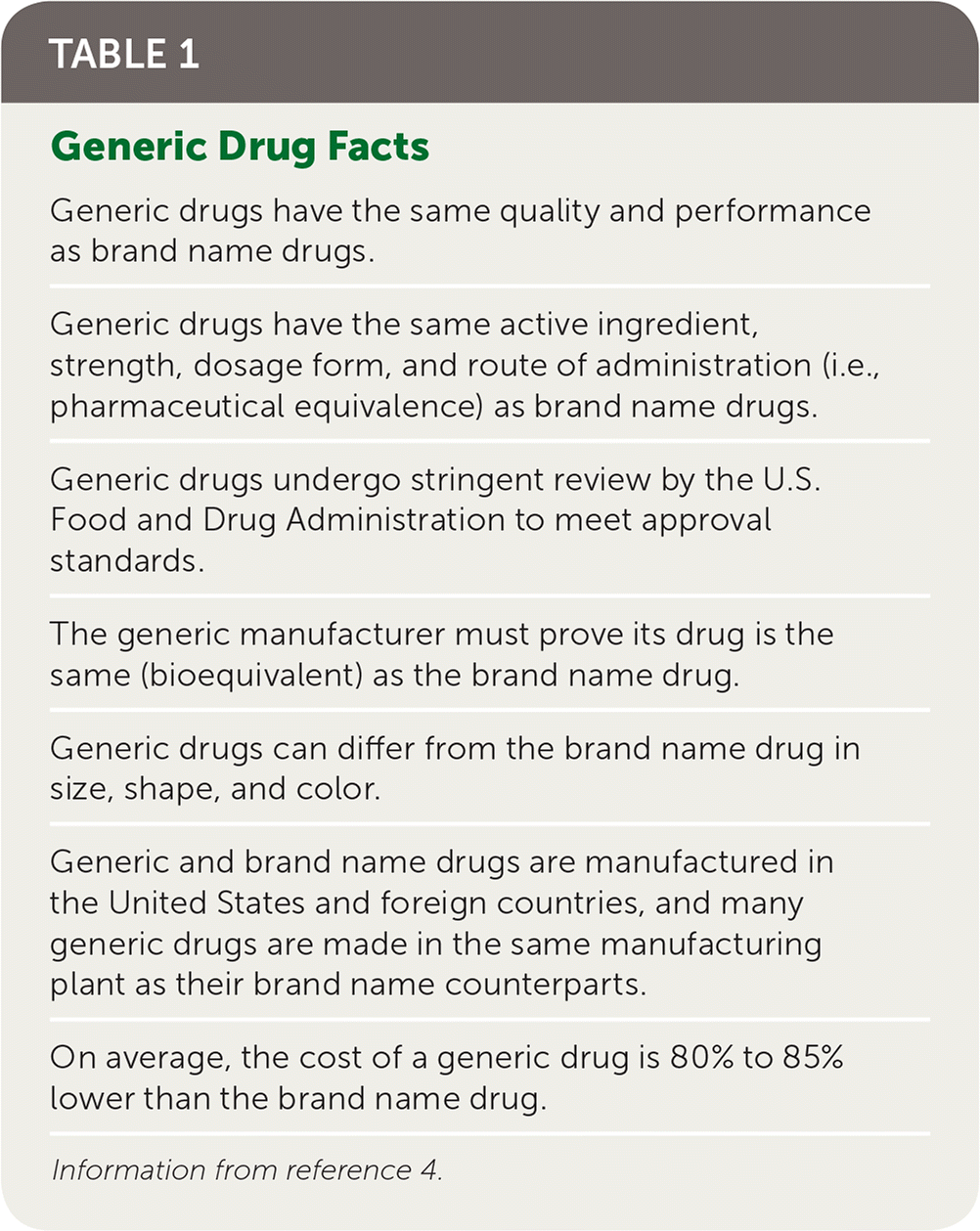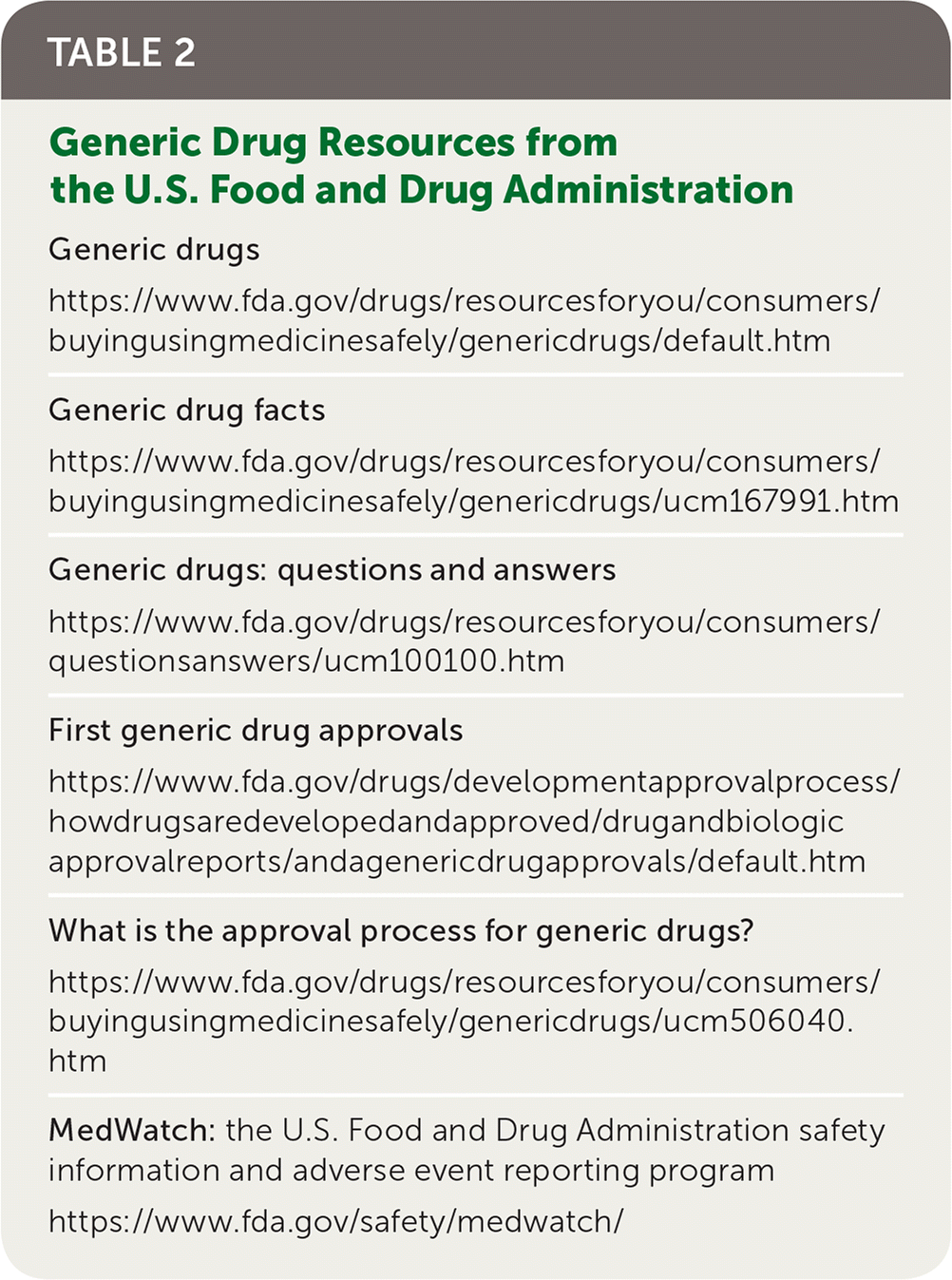
Am Fam Physician. 2018;97(11):696-697
See related AFP Community Blog post by Dr. Uhl: Practicing What I Preach About Generic Drugs
Author disclosure: No relevant financial affiliations.
Physician acceptance of generic drugs and, by extension, patient acceptance and medication adherence depend largely on trust that generic drugs adhere to strict standards to gain approval from the U.S. Food and Drug Administration (FDA). When a patient picks up a prescription at a pharmacy and receives a generic medication, FDA approval ensures that the generic drug works the same as the brand name drug. Although the FDA does not require comparative outcome studies for generic approval, multiple studies have demonstrated that generic drugs are equally effective as their brand counterparts (i.e., reference listed drugs).1,2
Generic drugs saved the U.S. health care system $1.67 trillion from 2007 to 2016, and comprised nearly 90% of prescriptions dispensed in the United States in 2016.3 Although generic drugs offer substantial cost savings to patients, justification for their broad use should be based on assurance of the quality and substitutability of generic drug products. There are high standards for safety, efficacy, and quality in the FDA's review of both brand and generic drugs.
A generic drug must meet FDA standards of pharmaceutical equivalence and bioequivalence compared with the brand name drug for which it will be substituted. Certain differences are permissible, such as shape, scoring, storage requirement, and minor labeling (or package insert) differences. Pharmaceutical equivalence requires that the active ingredient, strength, dosage, route of administration, and conditions of use be the same in both drugs. Bioequivalence means that there is no significant difference between the rate and extent of absorption of the generic compared with the brand name counterpart. Table 1 outlines several facts about generic drugs.4

| Generic drugs have the same quality and performance as brand name drugs. |
| Generic drugs have the same active ingredient, strength, dosage form, and route of administration (i.e., pharmaceutical equivalence) as brand name drugs. |
| Generic drugs undergo stringent review by the U.S. Food and Drug Administration to meet approval standards. |
| The generic manufacturer must prove its drug is the same (bioequivalent) as the brand name drug. |
| Generic drugs can differ from the brand name drug in size, shape, and color. |
| Generic and brand name drugs are manufactured in the United States and foreign countries, and many generic drugs are made in the same manufacturing plant as their brand name counterparts. |
| On average, the cost of a generic drug is 80% to 85% lower than the brand name drug. |
The FDA's generic review process recognizes that changes in a drug's formulation could influence the action of the active pharmaceutical ingredient in the body. The clinical relevance of changes in formulation and drug-release characteristics are carefully reviewed in the context of the drug's indication, target population, and chronicity of use. Generally, bioequivalence is demonstrated in the pharmacokinetic profile, comparing maximal concentration and the area under the curve of the proposed generic with the brand name counterpart.5 Thus, a modified-release drug designed to maintain the plasma concentration at a specific level for 24 hours would require special consideration of the shape of the pharmacokinetic curve as well as the maximal concentration and the area under the curve. For example, Ritalin LA (methylphenidate) is an extended-release capsule containing beads of immediate-release drug and enteric-coated beads for delayed release. The intent of this formulation is to simulate the plasma concentration of two doses of immediate-release Ritalin. For a generic version, partial area under the curve is measured at zero to three hours, three to seven hours, and seven to 12 hours after dosing to closely match the average area under the curve in the brand name drug and to achieve the pattern of drug release that is needed to produce the same clinical effect.6
FDA review of generic drug applications goes beyond demonstrating the same active pharmaceutical ingredients and bioequivalence. Generic drug approval also takes into account relevant clinical data and assurance that manufacturing facilities comply with current good manufacturing practices. More details on these regulations can be found at https://www.fda.gov/Drugs/DevelopmentApprovalProcess/Manufacturing/ucm090016.htm. The FDA's Center for Drug Evaluation and Research, Office of Generic Drugs, is the hub of the generic drug program, coordinating and collaborating across many FDA offices to determine if a generic drug application meets standards for approval. It typically takes multiple review cycles for a generic drug application to be approved, with each cycle lasting several months to almost a year. The Office of Generic Drugs works closely with the Center for Drug Evaluation and Research's Office of Pharmaceutical Quality, which ensures that high-quality generics are reviewed, inspected, and researched, while emphasizing chemistry, manufacturing, and controls.
Following approval and marketing, generic drug products undergo continued postmarketing surveillance to detect any quality issues and to investigate reports of potential therapeutic inequivalence. The FDA encourages consumers and health care professionals to report adverse drug effects to the FDA's MedWatch program (https://www.fda.gov/safety/medwatch/).7
The mission of the FDA's generic drug program is to provide high-quality, affordable generic medications to the American public. Table 2 provides links to FDA resources on generic drugs. Feedback from patient groups and the medical community informs the FDA's thinking about generic drug development and regulation. We want to assure all stakeholders of the rigorous approval process that supports the FDA's commitment to ensuring the high quality of generic drugs marketed in the United States.

| Generic drugs |
| Generic drug facts |
| Generic drugs: questions and answers |
| First generic drug approvals |
| What is the approval process for generic drugs? |
| MedWatch: the U.S. Food and Drug Administration safety information and adverse event reporting program |
